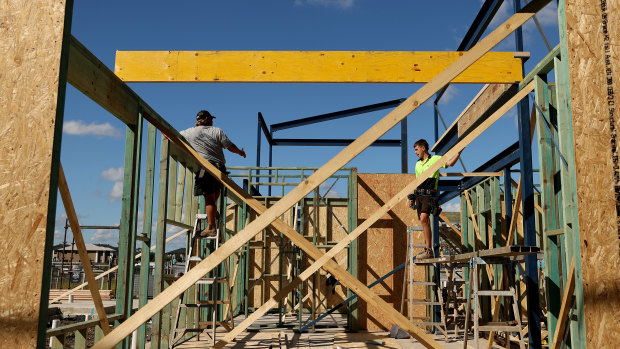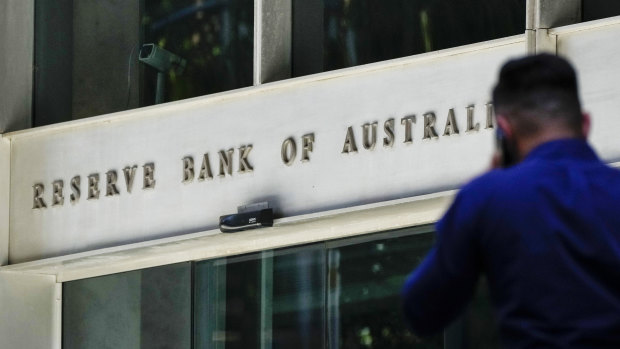Australia faces years of extreme rental and housing pain as the nation confronts a shortage of 106,000 dwellings by 2027 due to high-interest rates, soaring immigration and community opposition to new homes.
While new figures show dwelling values climbed 0.6 per cent in March after almost a year of falls, a report by the National Housing Finance and Investment Corporation (NHFIC) forecasts Brisbane alone will be short 12,300 dwellings within five years while Sydney will be short more than 10,000.
Australia is facing a 106,000 shortfall in new dwellings over the next decade.Credit:Bloomberg
The country is already facing extreme housing pressures with rental vacancy rates in every capital at or below 1 per cent, delays and growing costs hitting the dwelling construction sector, while bad weather through 2022 slowed building periods.
On Friday, building firm Porter Davis Homes collapsed, stopping work on 1700 projects in Victoria and Queensland. It also had 779 signed contracts with customers where construction was yet to start.
NHFIC, which is forecasting 1.8 million new households over the next decade, believes just 148,500 new dwellings will be added to the national housing stock this financial year, and that total will drop to 127,500 in 2024-25.
The corporation expects the biggest drop will be in apartments and multi-density dwellings. It expects a net 57,000 homes a year to be built over the next five years, 40 per cent down on levels experienced in the late 2010s.
Driving the increase in demand is high net migration, which this year is expected to reach 350,000 as overseas workers and students flood back in to the country.
But supply is falling, and the corporation found the availability of serviced land, high costs of construction, the faster-than-expected rise in interest rates, and “ongoing community opposition to new development” all contribute to the problem.
NHFIC chief executive Nathan Dal Bon said the combination of strong demand and low housing supply would weigh on the market for years with renters at particular risk.
“The rapid return of overseas migration together with a supply pipeline constrained by decade-high construction costs and significant increases in interest rates is exacerbating an already tight rental market,” he said.
“NHFIC analysis shows housing affordability and supply are likely to remain challenging for some time, underscoring the need for a holistic approach to mitigate the housing pressures Australians are facing.”
The biggest shortfall is expected in Perth. The corporation’s outlook report last year expected the western capital to build almost 11,000 dwellings more than required for its forecast population between 2022 and 2027. Now it is expecting a shortfall of 25,200 dwellings in the city.
Sydney has swung from a forecast surplus of 16,900 dwellings to a shortfall of 9600, Melbourne has improved slightly from a shortfall of 6200 to 1900, and Brisbane has deteriorated from a forecast 3300 surplus to a 12,300 deficit.
Another factor is the change in demand caused by the pandemic, with an extra 341,500 households created since mid-2021 as people moved out of share houses or family homes to be on their own.
Housing Minister Julie Collins, struggling to win support from the Senate for the government’s $10 billion Housing Australia Future Fund, said the report highlighted the need for more action on housing.
“This report is another reminder that too many Australians are struggling to secure safe and affordable housing,” she said.
The report came out as CoreLogic’s measure of dwelling values showed a 0.6 per cent rise in March – the first national increase in 11 months.
House values jumped by 1.5 per cent in Sydney, 0.6 per cent in Melbourne and by 0.5 per cent in Perth.
CoreLogic research director Tim Lawless said the result was driven by a surge in Sydney values.
The Reserve Bank meets on Tuesday with evidence the housing market may have bottomed.Credit:AP
“To see Sydney going from what’s been a moderating decline since September last year, moving to a very subtle growth last month, to now record a 1.4 per cent rise is quite a spectacular turnaround,” he said.
The increases come after large falls. Over the past 12 months, Sydney home values have fallen more than 12 per cent. In Melbourne, values have fallen 9 per cent, and in Brisbane values have dropped 8.6 per cent over the same period.
Lawless cautioned the market was bouncing around.
“The first thing I’d say is, it’s highly uncertain whether or not this can be sustained,” he said.
One factor lifting prices was the limited supply of properties for sale, which remains below five-year averages in Sydney and Melbourne. Another big factor adding to uncertainty about whether the market has turned is interest rates.
Lawless said it was unclear whether the Reserve Bank would pause its rate hikes on Tuesday after lifting the cash rate at 10 consecutive meetings to a 10-year high of 3.6 per cent.
Cut through the noise of federal politics with news, views and expert analysis from Jacqueline Maley. Subscribers can sign up to our weekly Inside Politics newsletter here.
Most Viewed in Politics
From our partners
Source: Read Full Article


